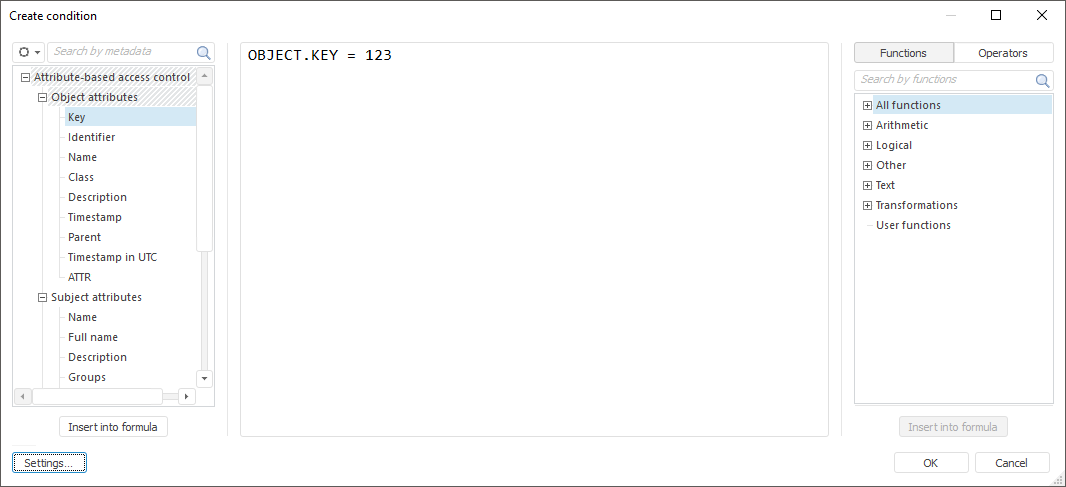
On using attribute-based access control method, additional access check conditions can be set in each of policy rules.
To create additional conditions of access check:
Select a rule.
In the window right part the rule properties are displayed, containing additional conditions to check access:

Set additional conditions to check access as a logical expression using one of the ways:
To open the dialog box, click the  button:
button:
In the desktop application in the right part of the security manager dialog box.
In the web application in the Properties side panel.
After executing one of the actions, the Create Condition dialog box opens:

To create an expression, see theCreating Formulas and Expressions section.
NOTE. The specified expression is displayed in the Condition field and in the Create Condition dialog box, independently of the expression creation method.
After executing the actions, the additional conditions to check access will be set.
To create an expression, the system and custom attributes that are contained in the attribute-based access control are available.
System attributes, for which a value based on information stored in the system, can be obtained, are divided into groups:
To control access permissions to table MDM dictionary elements, use the object attribute as OBJECT.ELEMENT.<attribute identifier>. Element attribute identifiers are located on the Attributes tab on opening dictionary for edit.
NOTE. The element attribute is set only in the rule additional condition.
For details see the Access Permissions for MDM Dictionary Elements section.
To create an expression, system functions and the ABAC functions are used:
| Name | Syntax and parameters | Description |
| Count | Syntax. ABAC.Count(<argument>). Parameters. Set as argument:
|
The Count method returns the number of values in the custom attribute array of subject or object and the number of groups where the user is included or the number of users in group. Examples:
The method returns the number of values in custom attribute array of the object with the ATTR identifier.
The method returns the number of groups where the user is included. |
| Is_Empty | Syntax. ABAC.Is_Empty(<argument>). Parameters. Set as argument:
|
The Is_Empty method determines the contents of the custom attribute value of subject or object and returns the value:
Examples:
The method returns True, if custom attribute of the object with the ATTR_OBJ identifier contain empty value, otherwise - False.
The method returns True, if custom attribute of the subject with the ATTR_USER identifier contain empty value, otherwise - False. |
| Interseca | Syntax. ABAC.Interseca(<argument_1>,..., <argument_n>), where n is the number of specified arguments. Parameters. Set as arguments:
NOTE. Value array must contain at least in one specified arguments. |
The Interseca method searches common values of the specified arguments and returns the value:
Examples:
The method returns True, if value array of object custom attribute with the ATTR_1 identifier and value array of subject custom attribute with the ATTR_2 identifier contains the 3.3 value, otherwise - False.
The method returns True, if value array of subject custom attribute with the ATTR_3 identifier and value array of object custom attribute with the ATTR_4 identifier contain common values, otherwise - False.
|
| Intersecc | Syntax. ABAC.Intersecc("<attribute property>", <argument_1>,..., <argument_n>), where n is the number of specified arguments. Parameters. Attribute property. Filtering collection attributes by the specified property. The attribute property is specified to the right from the point, for example, the NAME name is one of the properties of the SUBJECT.NAME attribute. Arguments. Set as arguments:
|
The Intersecc method searches common results of the specified arguments by the specified attribute property and returns the value:
Examples:
The method returns True, if the ADMIN group name corresponds to one of the names in the list of groups where user is included, otherwise - False.
The method returns True, if list of groups where the user is included and the value array of object attribute with the ATTR identifier contains at least one matching group name, otherwise - False. |
| FindAttr | Syntax. ABAC.FindAttr("<attribute property>", <subject attribute>, <searched value>, "<found attribute property>"). Parameters. Attribute property. Filtering collection attributes by the specified property. The attribute property is specified to the right from the point, for example, the NAME name is one of the properties of the SUBJECT.NAME attribute. Subject attribute. List of groups where user is included (SUBJECT.GROUPS) is set as an attribute. Searched value. Numeric or string searched value corresponding to the specified attribute value. Found attribute property. The property of found attribute which value needed to be found. |
The FindAttr method searches attribute by the specified property in the list of groups where the user is included or in the list of users in the group. It returns value of the found attribute specified property. Examples:
The method returns ADMIN, if the list of groups, where the user is included, contains the ADMIN group name.
The method returns SID of the ADMIN group, if the list of groups, where the user is included, contains the ADMIN group name. |
See also:
Setting Up Attribute-Based Access Control Method | Adding Access Check Rules and Policies